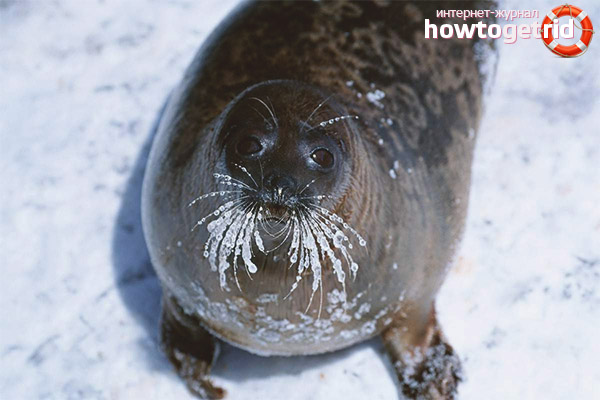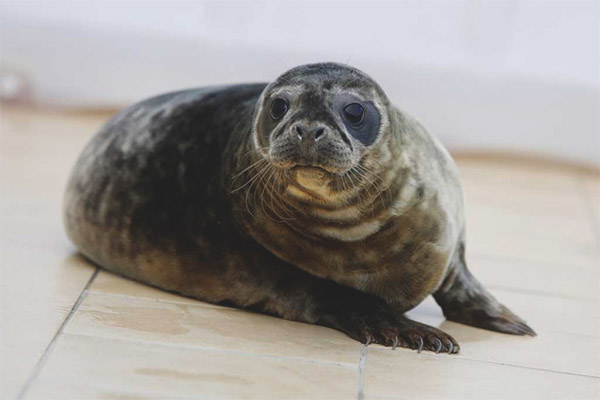The content of the article
Ringed seal resembles in its structure a small seal, whose weight is about 50 kg. The body looks short with a thick layer of fat. The small head is located on the squat neck. The skin is covered with a hard, slightly visible pile. Adult males and females have a different color - from black to yellow-brown tones. Throughout the body, except for flippers, scattered light rings.
Distribution area
These mammals are found mostly in the arctic and subarctic zones of the Atlantic and Pacific oceans. They prefer to live in the northern waters and belong to those inhabitants of the planet who feel comfortable only in cold and snowy regions.
Nerpa can be seen anywhere in the northern part of Russia, on the Murmansk coast, near the New Siberian Islands or the White Sea.The exceptions are the central part of the Barents Sea, where the seals do not appear, since there is no ice cover in this area.
Residents of the Far Eastern coast called the ringed seal, Akiba. Individuals begin to migrate from the western areas of the Coastal Sea, after which they move to the territory of the Commander and Aleutian Islands, populating the water area around the coast. In the Sea of Okhotsk arrange these settlements.
In addition to the seas of the Eurasian continent, the habitats of the nerves are the coast of Norway and Greenland, the Canadian Arctic Archipelago and Hudson Bay. The animal spends most of its life in the water, which is its source of nutrition.
Ringed seals have almost no tendency to migrate. With the arrival of summer heat, only the inhabitants of the eastern coast of the Barents Sea move to the neighboring water basin of the Kara Sea, and at the end of the season they return. Some individuals remain on the drifting ice, which the current carries to the open sea. However, the seals can even from a remote distance find the place where they lived in the summer or autumn.Migration is characteristic only for groups of mammals that inhabit the regions of the Okhotsk and Baltic Seas.
Diet
The Baltic Sea is a source of food, rich in sprats, gobies, cod and sprat, and the salty waters of the Coastal Sea - bale. With the arrival of autumn, Akibs more often manage to eat navaga or herring, the gerbil and gobies are rarely found. The spring ration of the seal consists of invertebrates such as mysids, black-eyed and scuds.
Breeding neprovyh individuals
Seals of the seal begin to be born in mid-March or April. Meetings of females and males for mating occur, as a rule, in the same period - April or May. A pregnant female has a calf for about 11 months. Small seals are born, wrapped in a protein shell, which falls down after a few weeks.Their weight does not exceed 4 kg, and the body length is 84 cm. The female feeds the offspring with milk for one month. This time is enough for the baby to be fully grown and mature. One year old seals have a weight of 14 kg. At age 7, juveniles weigh approximately 34 kg.
Achievement of puberty in females is observed at the age of 5-6 years. Each year, the average number of offspring ranges from 20-40%. Maturity of males comes a year later than that of females. In adult seals that are approaching ten years of age, growth stops.
Habits

Reproduction of seals occurs on the ice in the coastal area, but the inhabitants of the Sea of Okhotsk have adapted to the survival of drifting ice and are capable of breeding offspring even in such conditions.
The vast territory of thick, immovable ice surfaces allows animals to be placed alone, without forming clusters. Each individual has the opportunity to leave the flock and choose any hunting area and rookery. Drifting snow sites collect hundreds of seals in one place. To exit to the open sea, animals use lasks, through which they stick their heads and fill the lungs with oxygen.Near the laski, females make dens, hidden from prying eyes, to give birth to future small seals in this snowy shelter.
Number of individuals in the northern hemisphere
The ringed seal is one of the most common mammalian species found on the northern coasts. According to the latest data, their numbers approaching 5 million individuals. The bulk of the animals inhabits the territory of the Arctic. In the coastal waters of the Canadian Arctic archipelago, approximately one fifth of the total number of this subspecies is located. In the Sea of Okhotsk there are no more than 800 thousand heads, and the rest are dispersed in the coastal zones of the Eurasian continent.
Fishing and the value of the ringed seal
Product value is the skin, meat and seal fat. Due to the fishing of these mammals, subsistence farming is developed, which supports the population of the coastal areas of the north. The pinnipeds in the Soviet years laid the foundation for the development of the national economy.
Video: ringed seal (phoca hispida)











To send